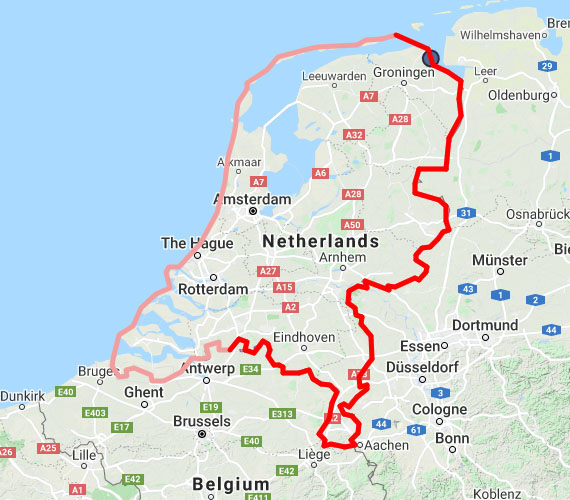Google Maps Animated Polyline
CSS
GoogleMaps
JavaScript
Website
jQuery

This demo shows two ways of showing the direction of a Google Maps PolyLine. One method is by moving an icon along the path of the PolyLine. The other method is by drawing another PolyLine on top of the other one section at a time to create an animation.
Download the JavaScript (Minified)
View source on GitHubCode Snippets
var map;
var polyline;
var bounds;
var linePartArr = [];
//timeout because jquery script is loaded later that this js file on this page
setTimeout(function () {
initializePolylineMap(52.52000, 5.28662);
}, 50);
//create the map
function initializePolylineMap(lat, lng) {
//coord for the center of the map
var startpos = new google.maps.LatLng(lat, lng);
//map options
var options = {
zoom: 8,
center: startpos,
zoomControl: true,
mapTypeControl: false,
scaleControl: false,
streetViewControl: false,
rotateControl: false,
fullscreenControl: false,
mapTypeId: google.maps.MapTypeId.TERRAIN
};
//start the map
map = new google.maps.Map(document.getElementById('map_canvas'), options);
//add bounds
bounds = new google.maps.LatLngBounds();
//create the polyline
createPolyLine();
//animate the polyline drawing
animatePolyline();
//animate the icon
animateIcon();
//make an array of maps coordinates for the bounds
for (var i = 0; i < lineCoordinates.length; i++) {
var pos = new google.maps.LatLng(lineCoordinates[i].lat, lineCoordinates[i].lng);
bounds.extend(pos);
}
//fit the map within the bounds
map.fitBounds(bounds);
}
//add a polyline to the map
function createPolyLine() {
//create a symbol to animate along the route
var lineSymbol = {
path: google.maps.SymbolPath.CIRCLE,
scale: 8,
fillColor: '#566895',
fillOpacity: 1,
strokeColor: '#282c41',
strokeOpacity: 1,
strokeWeight: 2
};
//create a polyline
polyline = new google.maps.Polyline({
path: lineCoordinates,
strokeColor: '#f39e9e',
strokeWeight: 5,
icons: [
{
icon: lineSymbol,
offset: '100%'
},
],
map: map
});
}
//animate the icon on the map
function animateIcon() {
var lineOffset = 0;
//experiment with the speed based on the length of the line
var iconSpeed = 0.2;
//move the icon
setInterval(function () {
lineOffset = (lineOffset + iconSpeed) % 200;
var lineIcon = polyline.get('icons');
lineIcon[0].offset = lineOffset / 2 + '%';
polyline.set('icons', lineIcon);
}, 20);
}
//animate the drawing of the polyline
function animatePolyline() {
var i = 0;
var pause = false;
var pauseLineRemove = 1500;
var pauseRedrawLine = 1000;
//experiment with the speed based on the total parts in the line
var drawSpeed = 50;
setInterval(function () {
//check if the end of the array is reached
if (i + 1 == lineCoordinates.length && !pause) {
pause = true;
//remove all the line parts, optionally with a delay to keep the fully drawn line on the map for a while
setTimeout(function () {
for (var j = 0; j < linePartArr.length; j++) {
linePartArr[j].setMap(null);
}
linePartArr = [];
}, pauseLineRemove);
//delay the drawing of the next animated line
setTimeout(function () {
pause = false;
i = 0;
}, pauseRedrawLine + pauseLineRemove);
}
//create a line part between the current and next coordinate
if (!pause) {
var part = [];
part.push(lineCoordinates[i]);
part.push(lineCoordinates[i + 1]);
//create a polyline
var linePart = new google.maps.Polyline({
path: part,
strokeColor: '#ff0000',
strokeOpacity: 1,
strokeWeight: 5,
zIndex: i + 2,
map: map
});
//add the polyline to an array
linePartArr.push(linePart);
i++;
}
}, drawSpeed);
}
In this example the Array lineCoordinates with the coordinates of the PolyLine is in the following format.
var lineCoordinates = [
{ lat: 53.531003, lng: 6.483307 },
{ lat: 53.441118, lng: 6.834869 },
{ lat: 53.339565, lng: 6.884308 }
];